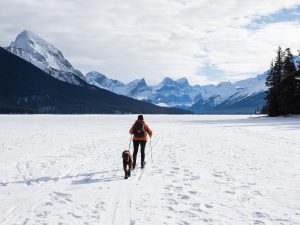
Cross-country skiier in Jasper, Canada.
Photo by @jasperguy
https://unsplash.com/photos/Dzd_O5cnr0Y
Researchers from across the globe have collaborated to identify criteria to apply in the selection of methods for studies focused on the impacts of outdoor recreation on terrestrial wildlife. Historical methods of study such as direct observation have benefits and drawbacks, while new technology opens possibilities for easily examining multi-species interaction. Ultimately, future methodology in this field should increase focus on the human component of human-wildlife interactions and must evaluate the long-term effects of disturbance due to recreation.

Lynx in Cape Breton, Canada. Photo by Thomas Lipke. https://unsplash.com/photos/MKRElkcGWtA
In a new globally reaching study, researchers from North America, Africa, and Europe have come together to propose a list of best practices for studying the impacts of outdoor recreation on terrestrial wildlife.
Through the analysis of 126 relevant papers researchers developed seven classifications for the methods used in the study of human-nature interaction. The categories most commonly used were direct observation, indirect observation (field-based), telemetry or GPS tracking, camera trapping, physiological measurement, trapping, and simulation.
As technology has developed it has become simpler to study the implications of human-wildlife interaction.
Direct observation, having a low barrier-cost to entry and few equipment requirements beyond a pen, paper, and perhaps a pair of binoculars, was the most popular study tactic among naturalists until 2003. The use of observation began to decrease relative to other methods after this point, resulting in a surge of popularity of newer technology such as camera trapping and telemetry. Modern camera trapping allows researchers to visualize multiple species at one time but has high associated costs and requires careful setup.

Kingley Vale National Nature Reserve, UK. Photo by Joshua Fuller. https://unsplash.com/photos/FiRKnSn4F20
Study methods must be carefully chosen so as to utilize resources efficiently while simultaneously creating minimal disturbance to the study population or to the outdoor recreation taking place. The methods chosen should be informed by the aim of the study, as well as by the species in question. Methods must also be chosen based on wether a single or multiple species will be studied in relation to the impacts of outdoor recreation. The type of recreation must also be considered alongside the types of disturbances created by the sport in question. Both the distribution and behavior of wildlife are influenced heavily by habitat, which plays another important role when considering methods for undertaking future studies. The ultimate constraint to methods is logistics such as time, research funding, study duration, and so forth.
As technology has improved, so too must the methods under which researchers operate.
The use of these criteria for developing methodology in future studies will produce work with a greater focus on the human basis of the interaction as well as the long-term effects of disturbance due to recreation on wildlife.
Sources:
Marion, S., Davies, A., Demsar, U., Irvine, R. J., Stephens, P. A., Long, J.
A systematic review of methods for studying the impacts of outdoor
recreation on terrestrial
wildlife. Global Ecology and Conservation. 2020: e00917.
https://doi.org/10.1016/j.gecco.2020.e00917
murphymv
Great article! I learned several new methods of wildlife tracking. This seems like a very relevant topic. I liked the emphasis on preventing wildlife disturbance.